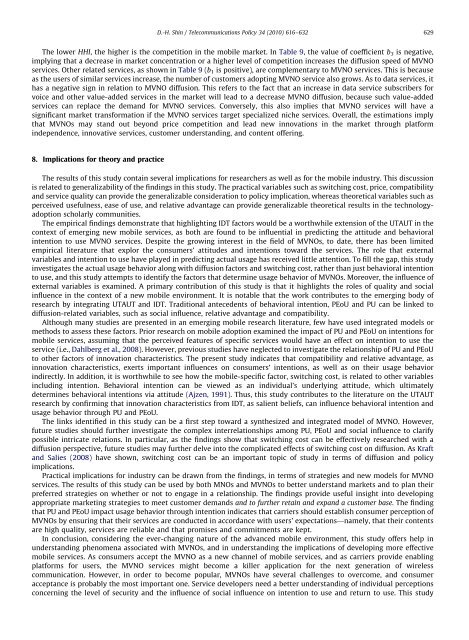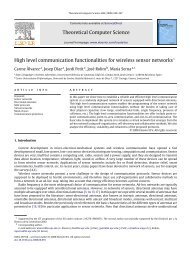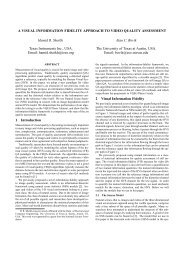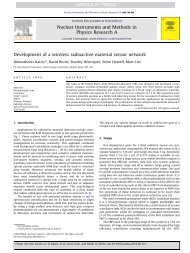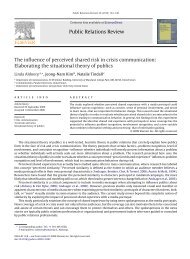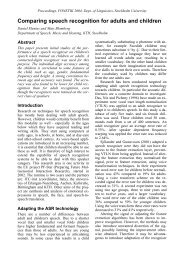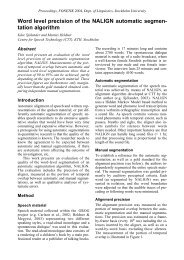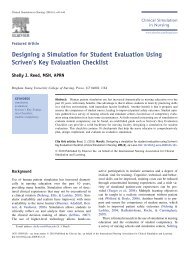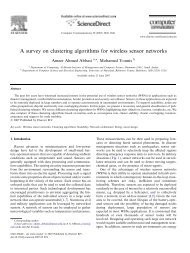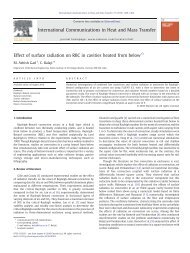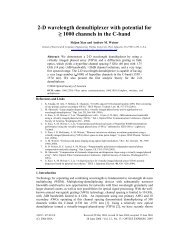MVNO services Policy implications for promoting MVNO diffusion
MVNO services Policy implications for promoting MVNO diffusion
MVNO services Policy implications for promoting MVNO diffusion
Create successful ePaper yourself
Turn your PDF publications into a flip-book with our unique Google optimized e-Paper software.
The lower HHI, the higher is the competition in the mobile market. In Table 9, the value of coefficient b3 is negative,<br />
implying that a decrease in market concentration or a higher level of competition increases the <strong>diffusion</strong> speed of <strong>MVNO</strong><br />
<strong>services</strong>. Other related <strong>services</strong>, as shown in Table 9 (b1 is positive), are complementary to <strong>MVNO</strong> <strong>services</strong>. This is because<br />
as the users of similar <strong>services</strong> increase, the number of customers adopting <strong>MVNO</strong> service also grows. As to data <strong>services</strong>, it<br />
has a negative sign in relation to <strong>MVNO</strong> <strong>diffusion</strong>. This refers to the fact that an increase in data service subscribers <strong>for</strong><br />
voice and other value-added <strong>services</strong> in the market will lead to a decrease <strong>MVNO</strong> <strong>diffusion</strong>, because such value-added<br />
<strong>services</strong> can replace the demand <strong>for</strong> <strong>MVNO</strong> <strong>services</strong>. Conversely, this also implies that <strong>MVNO</strong> <strong>services</strong> will have a<br />
significant market trans<strong>for</strong>mation if the <strong>MVNO</strong> <strong>services</strong> target specialized niche <strong>services</strong>. Overall, the estimations imply<br />
that <strong>MVNO</strong>s may stand out beyond price competition and lead new innovations in the market through plat<strong>for</strong>m<br />
independence, innovative <strong>services</strong>, customer understanding, and content offering.<br />
8. Implications <strong>for</strong> theory and practice<br />
D.-H. Shin / Telecommunications <strong>Policy</strong> 34 (2010) 616–632 629<br />
The results of this study contain several <strong>implications</strong> <strong>for</strong> researchers as well as <strong>for</strong> the mobile industry. This discussion<br />
is related to generalizability of the findings in this study. The practical variables such as switching cost, price, compatibility<br />
and service quality can provide the generalizable consideration to policy implication, whereas theoretical variables such as<br />
perceived usefulness, ease of use, and relative advantage can provide generalizable theoretical results in the technologyadoption<br />
scholarly communities.<br />
The empirical findings demonstrate that highlighting IDT factors would be a worthwhile extension of the UTAUT in the<br />
context of emerging new mobile <strong>services</strong>, as both are found to be influential in predicting the attitude and behavioral<br />
intention to use <strong>MVNO</strong> <strong>services</strong>. Despite the growing interest in the field of <strong>MVNO</strong>s, to date, there has been limited<br />
empirical literature that explor the consumers’ attitudes and intentions toward the <strong>services</strong>. The role that external<br />
variables and intention to use have played in predicting actual usage has received little attention. To fill the gap, this study<br />
investigates the actual usage behavior along with <strong>diffusion</strong> factors and switching cost, rather than just behavioral intention<br />
to use, and this study attempts to identify the factors that determine usage behavior of <strong>MVNO</strong>s. Moreover, the influence of<br />
external variables is examined. A primary contribution of this study is that it highlights the roles of quality and social<br />
influence in the context of a new mobile environment. It is notable that the work contributes to the emerging body of<br />
research by integrating UTAUT and IDT. Traditional antecedents of behavioral intention, PEoU and PU can be linked to<br />
<strong>diffusion</strong>-related variables, such as social influence, relative advantage and compatibility.<br />
Although many studies are presented in an emerging mobile research literature, few have used integrated models or<br />
methods to assess these factors. Prior research on mobile adoption examined the impact of PU and PEoU on intentions <strong>for</strong><br />
mobile <strong>services</strong>, assuming that the perceived features of specific <strong>services</strong> would have an effect on intention to use the<br />
service (i.e., Dahlberg et al., 2008). However, previous studies have neglected to investigate the relationship of PU and PEoU<br />
to other factors of innovation characteristics. The present study indicates that compatibility and relative advantage, as<br />
innovation characteristics, exerts important influences on consumers’ intentions, as well as on their usage behavior<br />
indirectly. In addition, it is worthwhile to see how the mobile-specific factor, switching cost, is related to other variables<br />
including intention. Behavioral intention can be viewed as an individual’s underlying attitude, which ultimately<br />
determines behavioral intentions via attitude (Ajzen, 1991). Thus, this study contributes to the literature on the UTAUT<br />
research by confirming that innovation characteristics from IDT, as salient beliefs, can influence behavioral intention and<br />
usage behavior through PU and PEoU.<br />
The links identified in this study can be a first step toward a synthesized and integrated model of <strong>MVNO</strong>. However,<br />
future studies should further investigate the complex interrelationships among PU, PEoU and social influence to clarify<br />
possible intricate relations. In particular, as the findings show that switching cost can be effectively researched with a<br />
<strong>diffusion</strong> perspective, future studies may further delve into the complicated effects of switching cost on <strong>diffusion</strong>. As Kraft<br />
and Salies (2008) have shown, switching cost can be an important topic of study in terms of <strong>diffusion</strong> and policy<br />
<strong>implications</strong>.<br />
Practical <strong>implications</strong> <strong>for</strong> industry can be drawn from the findings, in terms of strategies and new models <strong>for</strong> <strong>MVNO</strong><br />
<strong>services</strong>. The results of this study can be used by both MNOs and <strong>MVNO</strong>s to better understand markets and to plan their<br />
preferred strategies on whether or not to engage in a relationship. The findings provide useful insight into developing<br />
appropriate marketing strategies to meet customer demands and to further retain and expand a customer base. The finding<br />
that PU and PEoU impact usage behavior through intention indicates that carriers should establish consumer perception of<br />
<strong>MVNO</strong>s by ensuring that their <strong>services</strong> are conducted in accordance with users’ expectations—namely, that their contents<br />
are high quality, <strong>services</strong> are reliable and that promises and commitments are kept.<br />
In conclusion, considering the ever-changing nature of the advanced mobile environment, this study offers help in<br />
understanding phenomena associated with <strong>MVNO</strong>s, and in understanding the <strong>implications</strong> of developing more effective<br />
mobile <strong>services</strong>. As consumers accept the <strong>MVNO</strong> as a new channel of mobile <strong>services</strong>, and as carriers provide enabling<br />
plat<strong>for</strong>ms <strong>for</strong> users, the <strong>MVNO</strong> <strong>services</strong> might become a killer application <strong>for</strong> the next generation of wireless<br />
communication. However, in order to become popular, <strong>MVNO</strong>s have several challenges to overcome, and consumer<br />
acceptance is probably the most important one. Service developers need a better understanding of individual perceptions<br />
concerning the level of security and the influence of social influence on intention to use and return to use. This study


